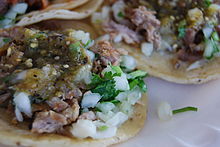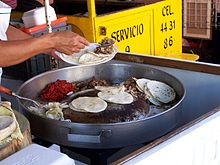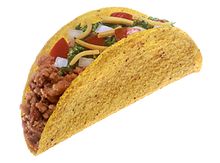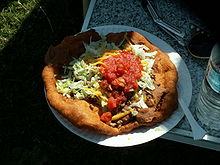- Taco
-
Not to be confused with Tako (disambiguation).
A taco (
 /ˈtɑːkoʊ/) is a traditional Mexican dish composed of a corn or wheat tortilla folded or rolled around a filling. A taco can be made with a variety of fillings, including beef, chicken, seafood, vegetables and cheese, allowing for great versatility and variety. A taco is generally eaten without utensils and is often accompanied by garnishes such as salsa, avocado or guacamole, cilantro, tomatoes, onions and lettuce.
/ˈtɑːkoʊ/) is a traditional Mexican dish composed of a corn or wheat tortilla folded or rolled around a filling. A taco can be made with a variety of fillings, including beef, chicken, seafood, vegetables and cheese, allowing for great versatility and variety. A taco is generally eaten without utensils and is often accompanied by garnishes such as salsa, avocado or guacamole, cilantro, tomatoes, onions and lettuce.Contents
Etymology
According to the Real Academia Española, publisher of Diccionario de la Lengua Española, the word taco describes a typical Mexican dish of a maize tortilla folded around food ("Tortilla de maíz enrollada con algún alimento dentro, típica de México"). The original sense of the word is of a "plug" or "wad" used to fill a hole ("Pedazo de madera, metal u otra materia, corto y grueso, que se encaja en algún hueco").[1] The Online Etymological Dictionary defines taco as a "tortilla filled with spiced meat" and describes its etymology as derived from Mexican Spanish, "light lunch," literally, "plug, wadding."[2]
History
The taco predates the arrival of Europeans in Mexico. There is anthropological evidence that the indigenous people living in the lake region of the Valley of Mexico traditionally ate tacos filled with small fish. Writing at the time of the Spanish conquistadors, Bernal Díaz del Castillo documented the first taco feast enjoyed by Europeans, a meal which Hernán Cortés arranged for his captains in Coyoacán.[3][4] It is not clear why the Spanish used their word, "taco", to describe this indigenous food.
Traditional tacos
There are many traditional varieties of tacos:
- Tacos de Asador ("spit" or "grill" tacos) may be composed of any of the following: carne asada tacos; tacos de tripita ("tripe tacos"), grilled until crisp; and, chorizo asado (traditional Spanish style sausage). Each type is served on two overlapped small tortillas and sometimes garnished with guacamole, salsa, onions, and cilantro. Also prepared on the grill is a sandwiched taco called mulita ("little mule") made with meat served between two tortillas and garnished with Oaxaca style cheese. "Mulita" is used to describe these types of sandwiched tacos in the Northern States of Mexico, while they are known as Gringa in the Mexican south and are prepared using wheat flour tortillas. Tacos may also be served with salsa.[5][6]
- Tacos de Cabeza or head tacos, in which there is a flat punctured metal plate from which steam emerges to cook the head of the cow. These include: Cabeza, a serving of the muscles of the head; Sesos ("brains"); Lengua ("tongue"); Cachete ("cheeks"); Trompa ("lips"); and, Ojo ("eye"). Tortillas for these tacos are warmed on the same steaming plate for a different consistency. These tacos are typically served in pairs, and also include salsa, onion and cilantro with occasional use of guacamole.[5][6]
- Tacos de Cazo for which a metal bowl filled with lard is typically used as a deep-fryer. Meats for these types of tacos typically include: Tripa ("tripe", usually from a pig instead of a cow); Suadero (tender beef cuts), Carnitas and Buche (Literally, "crop", as in bird's crop; here, it is fried pig's esophagus.[7])[5][6]
- Tacos sudados ("sweaty tacos") are made by filling soft tortillas with a spicy meat mixture, then placing them in a basket covered with cloth. The covering keeps the tacos warm and traps steam ("sweat") which softens them.[5][8]
- Tacos Al pastor/De Adobada ("shepherd style") are made of thin pork steaks seasoned with adobo seasoning, then skewered and overlapped on one another on a vertical rotisserie cooked and flame-broiled as it spins (analogous to the Döner kebab used in Greek restaurants to prepare gyros).[5][6]
- Tacos dorados (fried tacos, literally, "golden tacos") called flautas ("flute", because of the shape), or taquitos, for which the tortillas are filled with pre-cooked shredded chicken, beef or barbacoa, rolled into an elongated cylinder and deep-fried until crisp. They are sometimes cooked in a microwave oven or broiled.[5][6]
- Tacos de pescado ("fish tacos") originated in Baja California in Mexico, where they consist of grilled or fried fish, lettuce or cabbage, pico de gallo, and a sour cream or citrus/mayonnaise sauce, all placed on top of a corn or flour tortilla. In the United States, they remain most popular in California, Colorado, and Washington. In California, they are often found at street vendors, and a regional variation is to serve them with cabbage and coleslaw dressing on top.[5][6]
- Tacos de camarones ("shrimp tacos") also originated in Baja California in Mexico. Grilled or fried shrimp are used, usually with the same accompaniments as fish tacos: lettuce or cabbage, pico de gallo, avocado and a sour cream or citrus/mayonnaise sauce, all placed on top of a corn or flour tortilla.[5][6][9]
As an accompaniment to tacos, many taco stands will serve whole or sliced red radishes, lime slices, salt, pickled or grilled chilis (hot peppers), and occasionally cucumber slices, or grilled cambray onions.
United States and Canada
Hard-shell tacos
Beginning from the early part of the twentieth century, various styles of tacos have become popular in the United States and Canada.[10] The style that has become most common is the hard-shell, U-shaped version first described in a cookbook authored by Fabiola Cabeza de Vaca Gilbert and published in Santa Fe, New Mexico in 1949. These have been sold by restaurants and by fast food chains. Even non-Mexican oriented fast food restaurants have sold tacos. Mass production of this type of taco was encouraged by the invention of devices to hold the tortillas in the U-shape as they were deep-fried. A patent for such a device was issued to New York restaurateur Juvenico Maldonado in 1950, based on his patent filing of 1947 (U.S. Patent No. 2,506,305).[11][12] Such tacos are crisp-fried corn tortillas filled with seasoned ground beef, cheese, lettuce, and sometimes tomato, onion, salsa, sour cream, and avocado or guacamole.[13] In this context, soft tacos are tacos made with wheat flour tortillas and filled with the same ingredients as a hard taco.[14]
Puffy tacos, taco kits, breakfast tacos and tacodillas
Since at least 1978, a variation called the "puffy taco" has been popular. Originating in San Antonio, Texas, uncooked corn tortillas (flattened balls of masa dough[15]) are quickly fried in hot oil until they expand and become "puffy".[16] Fillings are similar to hard-shell versions. Restaurants offering this style of taco have since appeared in other Texas cities, as well as in California, where Henry's brother, Arturo, opened Arturo's Puffy Taco in Whittier, not long after Henry's opened.[17][18]
Kits are available at grocery and convenience stores and usually consist of taco shells (corn tortillas already fried in a U-shape), seasoning mix and taco sauce. Commercial vendors for the home market also market soft taco kits with tortillas instead of taco shells.[19][20]
The breakfast taco, found in Tex-Mex cuisine, is filled with meat, eggs, or cheese, with other ingredients.[21]
The tacodilla contains melted cheese in between the two folded tortillas, thus resembling a quesadilla.[22]
Indian tacos
Indian tacos, sometimes known as Navajo tacos but served in various parts of the American West and Midwest, are made using frybread instead of tortillas. They are commonly served at pow-wows, festivals, and other gatherings.[23]
See also
- Taco rice
- Taco salad
- Taquito
- Tlayuda
- Mexican cuisine
- Korean taco
- List of sandwiches
References
- ^ "Definition: Taco". Real Academia Española. http://buscon.rae.es/draeI/SrvltConsulta?TIPO_BUS=3&LEMA=taco. Retrieved 2008-06-13.
- ^ "Online Etymological Dictionary - Taco". Douglas Harper. http://www.etymonline.com/index.php?search=taco&searchmode=none. Retrieved 2008-07-11.
- ^ "History of Mexican Cuisine". Margaret Parker. http://www.iccjournal.biz/StudentScholars/Undergraduate/history_of_mexican_cuisine.htm. Retrieved 2008-07-09.
- ^ "A Thumbnail History of Mexican Food". Jim Conrad. http://www.mexicanmercados.com/food/foodhist.htm. Retrieved 2008-07-09.
- ^ a b c d e f g h Graber, Karen Hursh. "Wrap It Up: A Guide to Mexican Street Tacos (Part One of Two)". Mexico Connect. http://www.mexconnect.com/mex_/recipes/puebla/kgtacos1.html. Retrieved 2008-07-07.
- ^ a b c d e f g Graber, Karen Hursh. "Wrap It Up: A Guide to Mexican Street Tacos Part II: Nighttime Tacos". Mexico Connect. http://www.mexconnect.com/mex_/recipes/puebla/kgtacos2.html. Retrieved 2008-07-07.
- ^ Feld, Jonah (2006). "The Burrito Blog — Buche". http://www.burritoblog.com/2006/04/buche_yummy_pig.html. Retrieved 2008-07-26.
- ^ "Tacos Sudados (Mexican recipe)". Mexican Cuisine. http://cocina-mexico.com/ingles/menu/typical_food/20.html. Retrieved 2008-07-09.
- ^ Graber, Karen Hursh. "Tacos de camaron y nopalitos". Mexico Connect. http://www.mexconnect.com/articles/3447-shrimp-and-nopal-tacos-tacos-de-camaron-y-nopalitos. Retrieved 2009-08-14.
- ^ "Tacos, Enchilidas and Refried Beans: The Invention of Mexican-American Cookery". Oregon State University. Archived from the original on 2007-07-18. http://web.archive.org/web/20070718154326/http://food.oregonstate.edu/ref/culture/mexico_smith.html. Retrieved 2008-07-14.
- ^ US 2506305, Maldonado, Juvencio, "Form for frying tortillas to make fried tacos", published 1947-06-21, issued 1950-05-02
- ^ Pilcher, Jeffrey (Winter 2008). "Was the Taco Invented in Southern California?". Gastronomica (Berkeley, California: University of California Press) 8 (1): 26–38. doi:10.1525/gfc.2008.8.1.26. ISSN 1529-3262.
- ^ Gilb, Dagoberto (2006-03-19). "Taco Bell Nation". Los Angeles Times. http://www.latimes.com/features/magazine/west/la-tm-tacobell12mar19,0,3787670.story. Retrieved 2008-07-24.
- ^ "Homemade Chorizo Soft Tacos (recipe)". BigOven.com. http://www.bigoven.com/14723-(Homemade-Fresh)-Chorizo-Soft-Tacos-recipe.html. Retrieved 2008-07-09.
- ^ "Homemade Corn Tortillas (recipe from Saveur)". Saveur. 2003. http://www.saveur.com/food/classic-recipes/corn-tortillas--51762.html. Retrieved 2008-11-10.
- ^ "Puffy Tacos (recipe from Saveur)". Saveur. 2003. http://www.saveur.com/article/food/Puffy-Tacos. Retrieved 2008-07-26.
- ^ Gold, Jonathan (2008-07-23). "Getting Stuffed at Arturo’s Puffy Taco". LA Weekly. LA Weekly LP. http://www.laweekly.com/2008-07-24/eat-drink/the-air-in-there/. Retrieved 2011-08-14.
- ^ Chisholm, Barbara (2004-04-30). "The Puffy Taco Invasion". The Austin Chronicle (Austin Chronicle Corp) 23 (35). http://www.austinchronicle.com/gyrobase/Issue/story?oid=oid:208403. Retrieved 2011-08-14.
- ^ "Old El Paso Taco Dinner Kit". Ciao! Shopping Intelligence — UK (blog). http://www.ciao.co.uk/Old_El_Paso_Taco_Dinner_Kit__5314334. Retrieved 2008-07-08.
- ^ "Ortega Taco Kits". B&G Foods. http://www.ortega.com/products/products.php?id=4. Retrieved 2010-10-11.
- ^ Stradley, Linda. "Breakfast Tacos". What's Cooking America. http://whatscookingamerica.net/Eggs/BreakfastTaco.htm. Retrieved 2008-07-09.
- ^ "Green tomato and corn tacodillas". Honest Fare. June 1, 2010. http://honestfare.com/green-tomato-and-corn-tacodillas/. Retrieved 13 November 2010.
- ^ "Navajo Fry Bread and Indian Tacos: History and Recipes of Navajo Fry Bread and Indian Tacos". Linda Stradley. http://www.whatscookingamerica.net/History/NavajoFryBread.htm. Retrieved 2009-03-09.
External links
- Taco Recipe Low sodium recipe to make beef tacos.
Categories:- Mexican cuisine
- Spanish loanwords
- Tortilla-based dishes
- Tex-Mex cuisine
- Sandwiches
- Fast food
- Street food
- Cuisine of the Southwestern United States
- Cuisine of the Western United States
- American cuisine
- New Mexican cuisine
Wikimedia Foundation. 2010.







